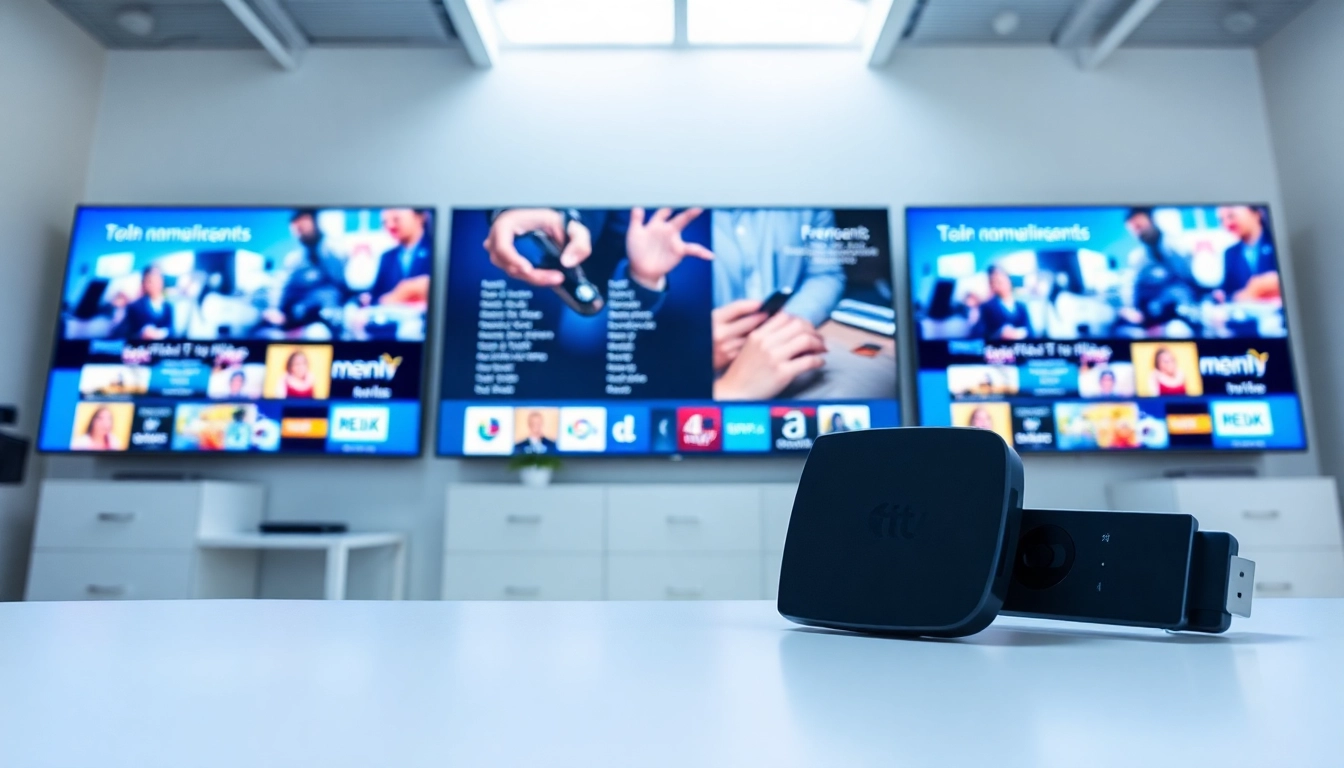Understanding the Fire TV Digital Signage App
What is the Fire TV Digital Signage App?
The Fire TV digital signage app is a powerful tool designed to transform ordinary displays into dynamic digital signage systems. It leverages the capabilities of Amazon’s Fire TV devices, allowing users to manage and display content like advertisements, playlists, menus, and announcements seamlessly. This app is particularly beneficial for businesses looking to enhance their communication and marketing strategies by leveraging visual engagement.
In essence, it allows users to utilize their existing TV screens as versatile digital canvases. By connecting a Fire TV device, users can upload images, videos, and live feeds, orchestrating a variety of content to be consumed by audiences in retail spaces, restaurants, corporate environments, and more. The flexibility and ease of use of the Fire TV digital signage app make it an invaluable resource for marketing and communication efforts.
Key Features of the Fire TV Digital Signage App
Among the many features included within the Fire TV digital signage app, a few stand out for their usability and impact:
- Cloud-Based Content Management: Easily upload and manage content through a web-based interface, ensuring flexibility and real-time updates.
- Multimedia Support: Support for various content types, including images, videos, and live streams, enables diverse presentation styles.
- Scheduling and Automation: Users can schedule content to play at specific times, automatically rotating through predefined playlists, which enhances efficiency.
- User-Friendly Interface: Designed with ease of use in mind, even non-technical users can navigate the app and create compelling displays.
- Remote Management: Allows for content updates and screen management from any location, ensuring that businesses can adapt to changing needs and messages promptly.
Importance of Digital Signage in Modern Business
Digital signage has evolved from simple display solutions to essential components of modern business communication. Its importance lies in its ability to engage customers effectively and convey messages in a visually appealing way. Here are several reasons why digital signage is critical in today’s market:
- Enhanced Customer Engagement: Moving visuals and interactive content capture attention better than static displays, leading to increased interaction and retention.
- Cost-Effective Marketing: Digital signage reduces printing costs associated with traditional marketing materials and allows for rapid content updates without additional financial burden.
- Real-Time Information: Businesses can provide real-time data such as promotions, news updates, or social media feeds, keeping their communication timely and relevant.
- Data-Driven Insights: By integrating with analytics tools, businesses can monitor customer interactions and adjust their strategies based on performance metrics.
- Brand Consistency: Digital signage ensures that brand messages are consistently displayed across all locations, fostering brand recognition and loyalty.
Setting Up Your Fire TV Digital Signage App
Requirements for Installation
To get started with the Fire TV digital signage app, users must meet the following prerequisites:
- An Amazon Fire TV device (Fire TV Stick or Fire TV Cube)
- Access to a compatible display screen with HDMI input
- A stable internet connection for app downloads and content updates
- A web-enabled device (PC, tablet, or smartphone) to manage digital signage content
Step-by-Step Setup Process
Setting up the Fire TV digital signage app involves several straightforward steps:
- Set Up Your Fire TV Device: Connect your Fire TV stick to your display and follow on-screen instructions to connect it to Wi-Fi.
- Download the App: Navigate to the Amazon Appstore, search for the digital signage app, and install it on your device.
- Create an Account: Open the app and sign up for a user account. This account will allow you to manage your content online.
- Upload Content: Using your web-enabled device, log in to the app portal, where you can upload images, videos, and other media you wish to display.
- Configure Display Preferences: Select your desired display settings, including resolution and content scheduling.
- Preview and Launch: Before finalizing, preview your content to ensure everything appears as intended, then hit launch!
Troubleshooting Common Issues
While the Fire TV digital signage app is generally user-friendly, you may encounter some common issues during setup or operation. Here are a few strategies to troubleshoot:
- Connectivity Issues: Ensure your Fire TV is connected to the correct Wi-Fi network. Restart the device if connectivity problems persist.
- Content Not Displaying: Check that your content met the format requirements and that the scheduling settings are correct.
- App Crashing or Freezing: If the app crashes, try uninstalling and reinstalling it. Ensure your device is running the latest software version.
- Screen Resolution Problems: If the content appears distorted, confirm that the display settings match the specifications of your display.
Content Creation Strategies for Fire TV Digital Signage App
Best Practices for Engaging Content
Creating engaging content for the Fire TV digital signage app is crucial to capturing your audience’s attention. Consider the following best practices:
- Keep It Simple: Avoid cluttering your display with excessive text or images. Focus on a clean design that communicates your message effectively.
- Use High-Quality Visuals: Opt for high-resolution images and videos to ensure clarity and professionalism in your presentations.
- Incorporate Branding: Make sure your brand elements, such as logos and color schemes, are consistently incorporated into your content.
- Call to Action: Encourage viewer interaction by including clear calls to action, whether it’s to visit a website, follow on social media, or take advantage of a promotion.
Design Tips for Effective Digital Displays
Effective designs are critical in digital signage to help retain viewer interest. Here are some fundamental design tips:
- Utilize White Space: Effective use of white space can help direct focus on your central message and make your signage easier to read.
- Font Selection: Choose legible fonts. Ideally, use one or two font styles to maintain visual consistency and readability.
- Color Contrast: Make sure that the colors used for text and background have enough contrast to ensure legibility and viewer engagement.
- Consistent Layout: Stick to a consistent layout across different displays to foster familiarity and ease of understanding.
Utilizing Multimedia in Your Presentations
Integrating multimedia elements can significantly enhance the engagement of your digital signage. Here’s how to effectively use different multimedia elements:
- Videos: Short, engaging videos can convey messages quickly and effectively. Ensure they are high-quality and straightforward.
- Interactive Content: Depending on your audience and objectives, consider incorporating QR codes or touch-screen interfaces to encourage interaction.
- Animations: Simple animations can draw attention to vital information. Use them sparingly to avoid distraction.
Measuring Performance and Effectiveness
Key Performance Indicators for Digital Signage
To understand the effectiveness of your digital signage efforts, tracking key performance indicators (KPIs) is essential. Here are some critical KPIs to monitor:
- Engagement Rates: Track how many people interact with your digital signage, whether by responding to calls to action or engaging with content.
- Foot Traffic: Measure any changes in foot traffic patterns to see if the signage is helping to attract more visitors to your location.
- Content Views: Use analytics tools to determine which pieces of content are viewed most often, helping you refine your content strategy.
- Sales Metrics: Link your digital signage campaigns with sales data to analyze directly if the signage is influencing buying behavior.
- Customer Feedback: Gather feedback from customers regarding their perceptions of the signage. This qualitative data can provide context to your numeric metrics.
Analyzing Audience Engagement Data
Once you’ve collected data, analyzing it effectively can yield actionable insights. Use the following methods:
- Data Visualization: Utilize graphs and charts to make complex data more understandable. Highlight key trends and insights.
- Segment Analysis: Break down data by audience segments to determine which demographics engage most with your signage.
- Periodic Review: Regularly review performance reports to identify successful campaigns and areas for improvement.
Adapting Content Based on Feedback
Making iterative improvements to your digital content is vital for ongoing engagement. Here’s how to adapt:
- Responsive Content Management: Use insights from audience interactions to tailor your content continuously, ensuring it remains relevant and engaging.
- Testing Variations: Conduct A/B testing on different messages, styles, or formats to understand what resonates best with your audience.
- Regular Updates: Keep content fresh by rotating it regularly, especially in high-traffic areas. Stale content can lead to decreased engagement.
Advanced Features and Future Trends
Integrating Interactive Elements
As technology advances, so does the potential for dynamic and interactive digital signage. Here are some ways to integrate interactive elements:
- Touch Screens: Implementing touch functionality allows viewers to interact directly with your content, enhancing engagement.
- Social Media Feeds: Incorporate real-time social media streams to foster community interaction and make your displays more dynamic.
- QR Codes and NFC: Use QR codes or Near Field Communication (NFC) technology to link viewers to additional content or promotions on their mobile devices.
Emerging Technologies in Digital Signage
Staying ahead means being aware of emerging technologies that can enhance the effectiveness of your digital signage:
- Artificial Intelligence: AI can personalize content based on real-time analytics, tailoring messages to specific audience segments.
- Augmented Reality: AR can create immersive experiences that blend the digital and physical worlds, enhancing viewer engagement.
- Internet of Things (IoT): IoT integration can facilitate dynamic updates based on environmental factors, such as time of day or current promotions.
Future-Proofing Your Digital Strategy
To ensure your digital signage strategy remains effective in the years ahead, consider the following approaches:
- Scalability: Invest in scalable solutions that can expand as your business grows. This flexibility will allow you to adapt your signage network over time.
- Cross-Platform Compatibility: Ensure all new digital signage technologies work seamlessly across different platforms and devices.
- Training and Development: Continuously invest in training for your staff on the latest digital signage technologies and best practices to leverage their full potential.



